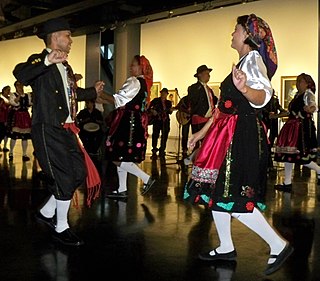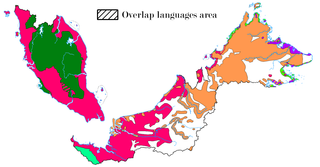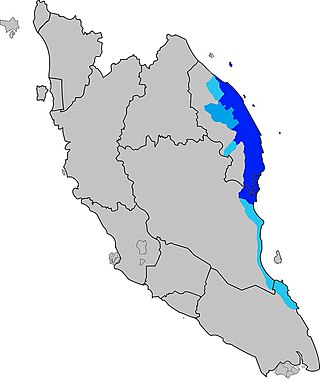Related Research Articles

The demographics of Malaysia are represented by the multiple ethnic groups that exist in the country. Malaysia's population, according to the 2010 census, is 28,334,000 including non-citizens, which makes it the 42nd most populated country in the world. Of these, 5.72 million live in East Malaysia and 22.5 million live in Peninsular Malaysia. The population distribution is uneven, with some 79% of its citizens concentrated in Peninsular Malaysia, which has an area of 131,598 square kilometres (50,810.27 sq mi), constituting under 40% of the total area of Malaysia.

Malay is an Austronesian language that is an official language of Brunei, Indonesia, Malaysia, and Singapore, and that is also spoken in East Timor and parts of Thailand. Altogether, it is spoken by 290 million people across Maritime Southeast Asia.

The Peranakans are an ethnic group defined by their genealogical descent from the first waves of Southern Chinese settlers to maritime Southeast Asia, known as Nanyang, namely the British Colonial ruled ports in the Malay Peninsula and the Indonesian Archipelago, as well as Singapore. Peranakan culture, especially in the dominant Peranakan centres of Malacca, Singapore, Penang, Phuket and Tangerang, is characterized by its unique hybridization of ancient Chinese culture with the local cultures of the Nusantara region, the result of a centuries-long history of transculturation and interracial marriage.
Papia Kristang or Kristang is a creole language spoken by the Kristang, a community of people of mixed Portuguese and indigenous Malay ancestry, chiefly in Malacca, Malaysia, Singapore and Perth, Australia.
In addition to its classical and modern literary form, Malay had various regional dialects established after the rise of the Srivijaya empire in Sumatra, Indonesia. Also, Malay spread through interethnic contact and trade across the south East Asia Archipelago as far as the Philippines. That contact resulted in a lingua franca that was called Bazaar Malay or low Malay and in Malay Melayu Pasar. It is generally believed that Bazaar Malay was a pidgin, influenced by contact among Malay, Hokkien, Portuguese, and Dutch traders.

Chinese Malaysians, also commonly called locally as Malaysian Chinese, are Malaysian citizens of Han Chinese ethnicity. They form the second-largest ethnic group, after the Malay majority, and are 22.8% of the Malaysian population. Most of them are descendants of Southern Chinese immigrants who arrived in Malaysia between the early 19th and the mid-20th centuries. Malaysian Chinese form the second largest community of Overseas Chinese in the world, after Thai Chinese. Malaysian Chinese are traditionally dominant in the business sector of the Malaysian economy.
The Chitty, also known as the Chetty or Chetti Melaka, are a distinctive group of Tamil people found mainly and originally in Melaka, Malaysia, and in Singapore where they migrated to in the 18th and 19th centuries from Melaka, who are also known as the "Indian Peranakans" and have adopted Malay (mostly) and Chinese cultural practices whilst also retaining their Hindu faith and heritage. In the 21st century, their population stands at 2,000. The Chitty/Chetti community or Chettiar community, is from South India and are devout Hindus.
Southern Thai, also known as Dambro, Pak Tai, or "Southern language", is a Southwestern Tai ethnolinguistic identity and language spoken in southern Thailand as well as by small communities in the northernmost Malaysian states. It is spoken by roughly five million people, and as a second language by the 1.5 million speakers of Pattani and other ethnic groups such as the local Peranakans communities, Negritos, and other tribal groups. Most speakers are also fluent in or understand the Central Thai dialects.

The Kristang are a creole ethnic group of people of predominantly mixed Portuguese and Malaccan descent, with substantial Dutch, British, Jewish, Malay, Chinese and Indian heritage. They are based in Malaysia and to some extent in Singapore. People of this ethnicity have, besides Portuguese, a strong Dutch heritage due to intermarriages, which is common among the Kristang. In addition, due to persecution by the Portuguese Inquisition in the region, a lot of the Jews of Malacca assimilated into the Kristang community. The creole group arose in Malacca between the 16th and 17th centuries, when the city was a port and base of the Portuguese Empire. Some descendants speak a distinctive Kristang language or Malacca Portuguese, a creole based on Portuguese. Today the government classifies them as Portuguese Eurasians.
Sri Lankan Malay is a creole language spoken in Sri Lanka, formed as a mixture of Sinhala and Shonam, with Malay being the major lexifier. It is traditionally spoken by the Sri Lankan Malays and among some Sinhalese in Hambantota. Today, the number of speakers of the language have dwindled considerably but it has continued to be spoken notably in the Hambantota District of Southern Sri Lanka, which has traditionally been home to many Sri Lankan Malays.

The indigenous languages of Malaysia belong to the Mon-Khmer and Malayo-Polynesian families. The national, or official, language is Malay which is the mother tongue of the majority Malay ethnic group. The main ethnic groups within Malaysia are the Malay people, Han Chinese people and Tamil people, with many other ethnic groups represented in smaller numbers, each with its own languages. The largest native languages spoken in East Malaysia are the Iban, Dusunic, and Kadazan languages. English is widely understood and spoken within the urban areas of the country; the English language is a compulsory subject in primary and secondary education. It is also the main medium of instruction within most private colleges and private universities. English may take precedence over Malay in certain official contexts as provided for by the National Language Act, especially in the states of Sabah and Sarawak, where it may be the official working language. Furthermore, the law of Malaysia is commonly taught and read in English, as the unwritten laws of Malaysia continue to be partially derived from pre-1957 English common law, which is a legacy of past British colonisation of the constituents forming Malaysia. In addition, authoritative versions of constitutional law and statutory law are continuously available in both Malay and English.

Kedah Malay or Kedahan or as it is known in Thailand, Syburi Malay is a Malayic language mainly spoken in the northwestern Malaysian states of Perlis, Kedah, Penang, and northern Perak and in the southern Thai provinces of Trang and Satun. The usage of Kedah Malay was historically prevalent in southwestern Thailand before being superseded by the Thai language. Enclaves of Kedah Malay can be found in Kawthaung District in Myanmar; Ranong and Krabi in upper southern Thailand; Jaring Halus, Langkat and Aceh in Sumatra, Indonesia and up north in Bangkok, central Thailand, where most of the Kedah Malay speakers are descendants of historical settlers from Kedah.

Malay Indonesians are ethnic Malays living throughout Indonesia. They are one of the indigenous peoples of the country. Indonesian, the national language of Indonesia, is a standardized form of Riau Malay. There were numerous kingdoms associated with the Indonesian Malays along with other ethnicities in what is now Indonesia, mainly on the islands of Borneo and Sumatra. These included Srivijaya, the Melayu Kingdom, Dharmasraya, the Sultanate of Deli, the Sultanate of Siak Sri Indrapura, the Riau-Lingga Sultanate, the Sultanate of Bulungan, Pontianak Sultanate, and the Sultanate of Sambas. The 2010 census states that there are 8 million Malays in Indonesia; this number comes from the classification of Malays in East Sumatra and the coast of Kalimantan which is recognized by the Indonesian government. This classification is different from the Malaysia and Singapore census which includes all ethnic Muslims from the Indonesian archipelago as Malays.

Kedahan Malays or commonly known as Orang Utara ('Northerners'), are a sub-group of Malays native to northern Malay Peninsula in areas of both current and historical area of Kedah. They are among the oldest ethnic groups in the Malay peninsula with a history dating back 2,800 years as proven by the discovery of sites in Bujang Valley and historical documents from India, China and Arabia. Kedahan Malays are one of the largest Malay sub-groups in Malaysia, comprising at least 15% of the total Malaysian Malay population including those with Kedahan ancestry.

Terengganu Malay is a Malayic language spoken in the Malaysian state of Terengganu all the way southward to coastal Pahang and northeast Johor. It is the native language of Terengganu Malays and highly localised Chinese Peranakan community as well as a second language among the smaller Indian minority. The language has developed a distinct phonetic, syntactic and lexical distinctions which makes it mutually unintelligible for speakers from outside the east coast of Peninsular Malaysia especially those who speak Standard Malay/Malaysian. Terengganu Malay still shares close linguistic ties with neighbouring Kelantan-Pattani and Pahang of which it forms under the umbrella term of "East Coast Peninsular Malayic languages". These similarities have often confused many people outside the region, who usually interchange Terengganu Malay with Kelantan Malay, even though there are major phonological and vocabulary differences between the two.

Malacca, officially the Historic State of Malacca, is a state in Malaysia located in the southern region of the Malay Peninsula, facing the Strait of Malacca. The state is bordered by Negeri Sembilan to the north and west and Johor to the south. The exclave of Tanjung Tuan also borders Negeri Sembilan to the north. Its capital is Malacca City, which has been listed as a UNESCO World Heritage Site since 7 July 2008. Malacca City is 148 kilometres southeast of Malaysia's capital city Kuala Lumpur, 235 kilometres northwest of Johor's largest city Johor Bahru and 95 km northwest of Johor's second largest city, Batu Pahat.
Negeri Sembilan Malay is an Austronesian language spoken mainly in the Malaysian state of Negeri Sembilan, including Alor Gajah and parts of Jasin District in northern Malacca, and parts of Segamat District in the northernmost part of Johor. The language is spoken by the descendants of Minangkabau settlers from Sumatra, who have migrated to Negeri Sembilan since as early as the 14th century. It is often considered a variant or dialect of the Minangkabau language; lexical and phonological studies, however, indicate that it is more closely related to Standard Malay than it is to Minangkabau.
Malay is spoken by a minority of Filipinos, particularly in the Palawan, Sulu Archipelago and parts of Mindanao, mostly in the form of trade and creole languages, such as Sabah Malay.

Penangite Indians, also known as Chulias, are Malaysian Indians that live primarily in the state of Penang, Malaysia. Most are the descendants from those who migrated from India during the British colonisation of Malaya. However, historical sources prove that the ancient Indians arrived in Penang during the Chola dynasty. Penangite Indians forms a large percentage of the state's professional community such as business, law and medicine as well as politics, it can be proven by the appointment of Dr. P. Ramasamy as deputy chief minister of Penang. It made him the first Malaysian of Indian origin to hold the post of deputy chief minister in any state of Malaysia. In addition, first Tamil Vernacular School in Malaysia was established in Penang.

The Minangkabau Malaysians are citizens of the Malaysia whose ancestral roots are from Minangkabau of central Sumatra. This includes people born in the Malaysia who are of Minangkabau origin as well as Minangkabau who have migrated to Malaysia. Today, Minangkabau comprise about 989,000 people in Malaysia, and Malaysian law considers most of them to be Malays. They are majority in urban areas, which has traditionally had the highest education and a strong entrepreneurial spirit. The history of the Minangkabau migration to Malay peninsula has been recorded to have lasted a very long time. When the means of transportation were still using the ships by down the rivers and crossing the strait, many Minang people migrated to various regions such as Negeri Sembilan, Malacca, Penang, Kedah, Perak, and Pahang. Some scholars noted that the arrival of the Minangkabau to the Malay Peninsula occurred in the 12th century. This ethnic group moved in to peninsula at the height of the Sultanate of Malacca, and maintains the Adat Perpatih of matrilineal kinships system in Negeri Sembilan and north Malacca.
References
Citations
- ↑ Malay Chetty creole language at Ethnologue (25th ed., 2022)

- 1 2 "Malaccan Malay Creole". Ethnologue. Retrieved 2021-04-29.
- ↑ Paulo 2018.
- ↑ Mohamed 2009, pp. 58–59.
- ↑ Mohamed 2009, p. 68.
- ↑ Mohamed 2009, pp. 60–65.
- ↑ Mohamed 2009, pp. 67–68.
Bibliography
- Paulo, Derrick A (21 October 2018). "Meet the Chetti Melaka, or Peranakan Indians, striving to save their vanishing culture". CNA . Retrieved 28 April 2021.
- Mohamed, Noriah (June 2009). "The Malay Chetty Creole Language of Malacca: A Historical and Linguistic Perspective". Journal of the Malaysian Branch of the Royal Asiatic Society . 82 (1 (296)): 58–59. JSTOR 41493734 . Retrieved 23 May 2021– via JSTOR.